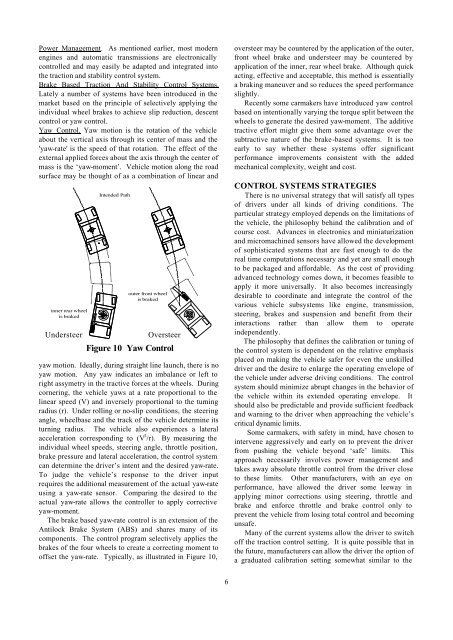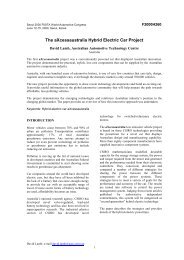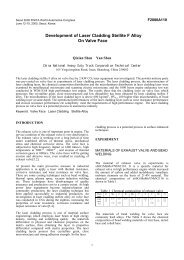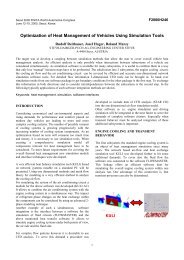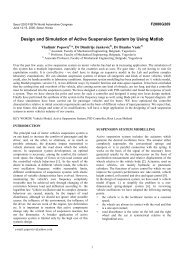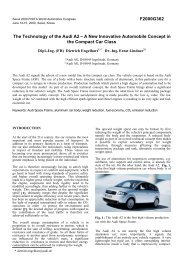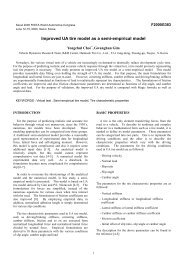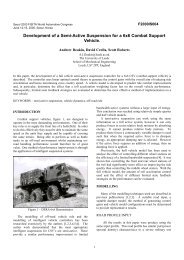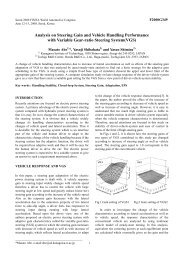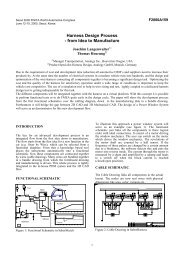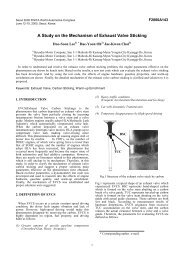All-Wheel Drive / Four-Wheel Drive Systems and Strategies
All-Wheel Drive / Four-Wheel Drive Systems and Strategies
All-Wheel Drive / Four-Wheel Drive Systems and Strategies
You also want an ePaper? Increase the reach of your titles
YUMPU automatically turns print PDFs into web optimized ePapers that Google loves.
Power Management. As mentioned earlier, most modern<br />
engines <strong>and</strong> automatic transmissions are electronically<br />
controlled <strong>and</strong> may easily be adapted <strong>and</strong> integrated into<br />
the traction <strong>and</strong> stability control system.<br />
Brake Based Traction And Stability Control <strong>Systems</strong>.<br />
Lately a number of systems have been introduced in the<br />
market based on the principle of selectively applying the<br />
individual wheel brakes to achieve slip reduction, descent<br />
control or yaw control.<br />
Yaw Control. Yaw motion is the rotation of the vehicle<br />
about the vertical axis through its center of mass <strong>and</strong> the<br />
'yaw-rate' is the speed of that rotation. The effect of the<br />
external applied forces about the axis through the center of<br />
mass is the ‘yaw-moment’. Vehicle motion along the road<br />
surface may be thought of as a combination of linear <strong>and</strong><br />
inner rear wheel<br />
is braked<br />
Understeer<br />
Intended Path<br />
outer front wheel<br />
is braked<br />
Oversteer<br />
Figure 10 Yaw Control<br />
yaw motion. Ideally, during straight line launch, there is no<br />
yaw motion. Any yaw indicates an imbalance or left to<br />
right assymetry in the tractive forces at the wheels. During<br />
cornering, the vehicle yaws at a rate proportional to the<br />
linear speed (V) <strong>and</strong> inversely proportional to the turning<br />
radius (r). Under rolling or no-slip conditions, the steering<br />
angle, wheelbase <strong>and</strong> the track of the vehicle determine its<br />
turning radius. The vehicle also experiences a lateral<br />
acceleration corresponding to (V 2 /r). By measuring the<br />
individual wheel speeds, steering angle, throttle position,<br />
brake pressure <strong>and</strong> lateral acceleration, the control system<br />
can determine the driver’s intent <strong>and</strong> the desired yaw-rate.<br />
To judge the vehicle’s response to the driver input<br />
requires the additional measurement of the actual yaw-rate<br />
using a yaw-rate sensor. Comparing the desired to the<br />
actual yaw-rate allows the controller to apply corrective<br />
yaw-moment.<br />
The brake based yaw-rate control is an extension of the<br />
Antilock Brake System (ABS) <strong>and</strong> shares many of its<br />
components. The control program selectively applies the<br />
brakes of the four wheels to create a correcting moment to<br />
offset the yaw-rate. Typically, as illustrated in Figure 10,<br />
oversteer may be countered by the application of the outer,<br />
front wheel brake <strong>and</strong> understeer may be countered by<br />
application of the inner, rear wheel brake. Although quick<br />
acting, effective <strong>and</strong> acceptable, this method is essentially<br />
a braking maneuver <strong>and</strong> so reduces the speed performance<br />
slightly.<br />
Recently some carmakers have introduced yaw control<br />
based on intentionally varying the torque split between the<br />
wheels to generate the desired yaw-moment. The additive<br />
tractive effort might give them some advantage over the<br />
subtractive nature of the brake-based systems. It is too<br />
early to say whether these systems offer significant<br />
performance improvements consistent with the added<br />
mechanical complexity, weight <strong>and</strong> cost.<br />
CONTROL SYSTEMS STRATEGIES<br />
There is no universal strategy that will satisfy all types<br />
of drivers under all kinds of driving conditions. The<br />
particular strategy employed depends on the limitations of<br />
the vehicle, the philosophy behind the calibration <strong>and</strong> of<br />
course cost. Advances in electronics <strong>and</strong> miniaturization<br />
<strong>and</strong> micromachined sensors have allowed the development<br />
of sophisticated systems that are fast enough to do the<br />
real time computations necessary <strong>and</strong> yet are small enough<br />
to be packaged <strong>and</strong> affordable. As the cost of providing<br />
advanced technology comes down, it becomes feasible to<br />
apply it more universally. It also becomes increasingly<br />
desirable to coordinate <strong>and</strong> integrate the control of the<br />
various vehicle subsystems like engine, transmission,<br />
steering, brakes <strong>and</strong> suspension <strong>and</strong> benefit from their<br />
interactions rather than allow them to operate<br />
independently.<br />
The philosophy that defines the calibration or tuning of<br />
the control system is dependent on the relative emphasis<br />
placed on making the vehicle safer for even the unskilled<br />
driver <strong>and</strong> the desire to enlarge the operating envelope of<br />
the vehicle under adverse driving conditions. The control<br />
system should minimize abrupt changes in the behavior of<br />
the vehicle within its extended operating envelope. It<br />
should also be predictable <strong>and</strong> provide sufficient feedback<br />
<strong>and</strong> warning to the driver when approaching the vehicle’s<br />
critical dynamic limits.<br />
Some carmakers, with safety in mind, have chosen to<br />
intervene aggressively <strong>and</strong> early on to prevent the driver<br />
from pushing the vehicle beyond ‘safe’ limits. This<br />
approach necessarily involves power management <strong>and</strong><br />
takes away absolute throttle control from the driver close<br />
to these limits. Other manufacturers, with an eye on<br />
performance, have allowed the driver some leeway in<br />
applying minor corrections using steering, throttle <strong>and</strong><br />
brake <strong>and</strong> enforce throttle <strong>and</strong> brake control only to<br />
prevent the vehicle from losing total control <strong>and</strong> becoming<br />
unsafe.<br />
Many of the current systems allow the driver to switch<br />
off the traction control setting. It is quite possible that in<br />
the future, manufacturers can allow the driver the option of<br />
a graduated calibration setting somewhat similar to the<br />
6


